Explore the intricacies of glider dynamics, focusing on stability, control, and efficiency, and learn advanced techniques for mastering the skies.

Glider Dynamics: Exploring Stability, Control, and Efficiency
Glider flight dynamics are a fascinating interplay of aerodynamics, physics, and engineering, offering unique insights into the art of flying without an engine. The key aspects of glider dynamics revolve around stability, control, and efficiency, each of which plays a critical role in ensuring a safe, enjoyable, and efficient soaring experience.
Understanding Glider Stability
Stability in gliders is about maintaining a steady flight path without constant pilot intervention. It can be categorized into two main types: static stability and dynamic stability. Static stability refers to a glider’s natural tendency to return to its original flight path after a disturbance, like a gust of wind. This is often achieved through design elements like dihedral wings, which automatically correct for small rolls. Dynamic stability, on the other hand, deals with the glider’s response over time after a disturbance. A dynamically stable glider will not only return to its original flight path but will do so in a way that dampens oscillations over time.
Control Aspects
Control in gliders is primarily achieved through the manipulation of ailerons, rudder, and elevators. Ailerons, located on the wingtips, control roll. The rudder, situated on the tail, manages yaw, helping the glider turn left or right. Elevators, also on the tail, control pitch, allowing the glider to climb or descend. Efficient control is vital for maneuvering, especially during thermalling, where pilots seek rising air currents to gain altitude.
Maximizing Efficiency
Efficiency in glider dynamics is measured by the glide ratio, which is the distance a glider can travel forward relative to the altitude it loses. High glide ratios indicate greater efficiency, allowing gliders to stay airborne longer and travel further. Factors influencing glide ratio include wing design, weight, and external conditions. Wings with a high aspect ratio (long and slender) typically offer better lift-to-drag ratios, enhancing efficiency. Pilots also play a role by optimizing flight paths and utilizing atmospheric conditions like thermals and ridge lift to extend flight duration.
The Role of Advanced Materials
Modern gliders benefit from advanced materials like carbon fiber and fiberglass, which offer an optimal balance between strength and weight. These materials have revolutionized glider design, allowing for sleeker, more aerodynamic shapes and lighter structures, which directly contribute to improved stability, control, and efficiency.
Understanding these dynamics is crucial for both novice and experienced pilots. It not only ensures a safer flying experience but also enhances the joy and challenge of gliding, making it a unique and rewarding endeavor in the realm of aviation.
Advanced Techniques in Glider Dynamics
Delving deeper into glider dynamics, we encounter advanced techniques that experienced pilots use to master the skies. These include fine-tuning control inputs, exploiting atmospheric conditions, and understanding the critical role of speed in different flight phases.
Mastering Control Inputs
Advanced control techniques involve smooth, coordinated use of ailerons, rudder, and elevators. Skilled pilots learn to anticipate the glider’s response, making subtle adjustments to maintain optimal flight conditions. This is especially crucial during cross-country flights, where varying weather conditions demand constant adaptation.
Exploiting Atmospheric Conditions
Pilots proficient in glider dynamics can expertly exploit atmospheric conditions. Thermals, updrafts of warm air, are used to gain altitude without engine power. Understanding how to locate and center in a thermal is an art, often requiring interpretation of visual cues like bird flight patterns and cloud formations. Ridge lift, generated by wind deflected upwards by a hill or mountain, is another phenomenon that can be used for sustained flight along the ridge.
Importance of Speed Management
Effective speed management is pivotal in glider flight. Different phases of flight, such as climbing in thermals, cruising in straight flight, or preparing for landing, require different speeds for optimal performance. For instance, during thermalling, a slower speed maximizes lift, while in cruising, a higher speed might be more efficient. Understanding the polar curve, which represents the glider’s performance at various speeds, is essential for making these judgements.
Conclusion: The Art and Science of Gliding
Glider dynamics blend the art of piloting with the science of aerodynamics. Stability, control, and efficiency are the pillars of this fascinating discipline, with each element contributing to the unique experience of engineless flight. Advances in materials and design have pushed the boundaries of what gliders can achieve, while the skill and knowledge of the pilot remain crucial to harnessing the full potential of these remarkable aircraft.
Whether it’s a peaceful soar along a ridge, an exhilarating climb in a thermal, or a strategic cross-country journey, gliding offers a pure and challenging form of flight. It’s a pursuit that demands a deep understanding of the forces at play, a keen awareness of the environment, and a continuous striving for harmony between pilot and machine. For those who embrace its challenges, gliding is not just a sport or a hobby; it’s a passionate pursuit of the freedom found in the skies.
